A Guide To Scrubber System On Ship
, 07/08/2021, 11:13 GMT+7
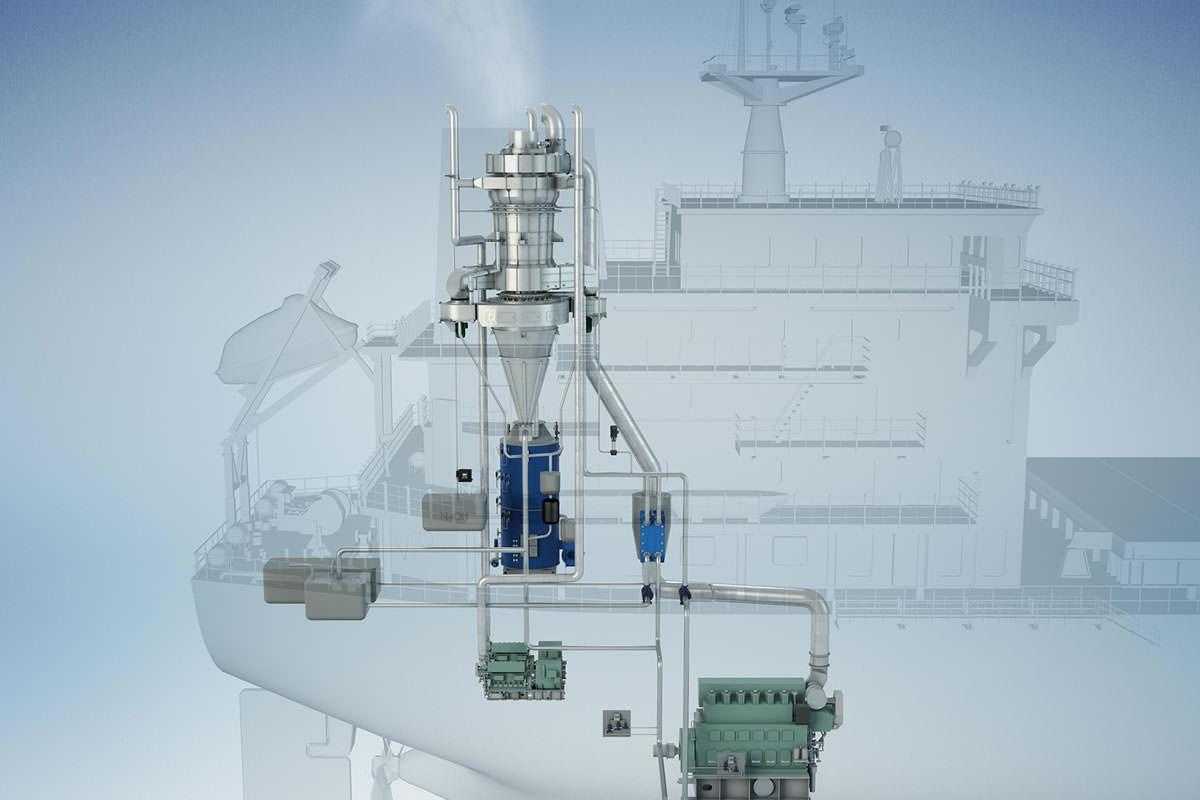
Scrubbers or Exhaust Gas Cleaning Systems (EGCS) are used to remove particulate matter and harmful components, such as sulphur oxides (SOx) and nitrogen oxides (NOx) from the exhaust gasses generated as a result of combustion processes in marine engines, to implement pollution control.
These scrubbing systems have been developed and employed to treat exhaust from main engines, auxiliary engines and boilers, onboard marine vessels, to ensure that no damage is done to human life and the environment by toxic chemicals.
Sulphur emissions to the atmosphere by sea-going vessels are limited by new and updated international regulations, which will come into effect starting 01 January 2020 under the Marpol Treaty
The International Maritime Organization (IMO) regulations mandate that the sulphur content in fuels, which is carried by merchant vessels, has to be limited to 0.50% globally and 0.10 % in ECAs (Emission Control Areas: The Baltic Sea Area, The North Sea area, The United States, Canada, and the United States Caribbean Sea area).
Before this, the maximum sulphur cap in fuels has been kept at 3.5% . Compliance with the new regulations requires that vessels either use expensive fuel with low sulphur content or clean the exhaust gases by using exhaust scrubbing systems.
Exhaust gas scrubbers are hence being installed on a substantial number of ships to comply with international regulations.
Classification of Marine Scrubbers
I. Open-loop scrubbers
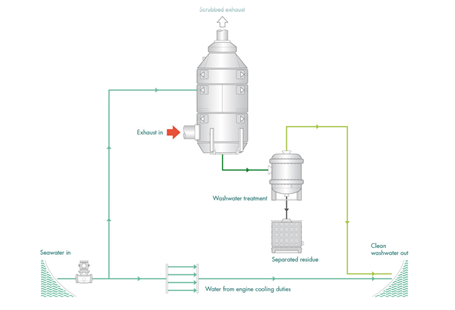
Instead of being re-used, the process water is discharged directly back to sea while complying fully to the IMO regulations.
How does it work?
• The seawater (process water) is NOT re-circulated but discharged back to sea.
• The sulphur in the exhaust gases dissolves in the process water.
• The process water is pumped through a water treatment system and discharged back to sea.
• Solids and oil from the process water are led to the separator.
• This separator will separate solids and oil from the process water.
• The remaining sludge is pumped to the sludge storage tank on the ship.
• The process water removed from solids and oil will be discharged back to sea.
• The pH, turbidity and concentration of PAH are constantly measured in accordance with MARPOL Annex VI resolution MEPC.184 (59).
• The clean exhaust gases exit the scrubber, removed from sulphur and particles, through a demister.
Advantages:
1. It has very few parts, the design is simple and easy to install on board.
2. Apart from de-fouling and operational checks, the system requires very less maintenance
3. This system does not require storage for waste materials
Disadvantages:
1. Cooling of the exhaust gas is a problem faced by wet scrubber systems.
2. A very large volume of sea water is required to obtain efficient cleaning and hence the system consumes very high power.
3. In ECA zones and ports, higher costing fuel has to be consumed.
II. Closed-loop scrubbers
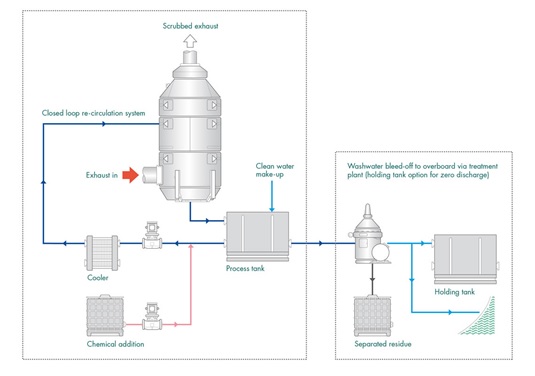
Closed loop exhaust gas cleaning system
The closed loop is the most frequently used system. The seawater used in the process is continuously re-circulated.
How does it work?
• From the bottom of the scrubber exhaust gases are led through the scrubber to the top.
• The seawater is fed into the top of the scrubber through nozzles. This results in an equally divided spray.
• The outgoing exhaust gases are washed with seawater in the scrubber.
• The seawater (process water) is continuously re-circulated.
• The sulphur in the exhaust gases dissolves in the process water pumped from a circulation tank and binds with the caustic soda (NaOH) as a salt.
• Based on conductivity level a certain amount of process water is drained out of the system automatically.
• If needed clean seawater is then added to the process water tank and also NaOH, if needed.
• The process water is pumped through the separator.
• This separator will separate solids and oil from the process water.
• The remaining sludge is pumped to the sludge storage tank on the ship.
• The process water with high conductivity level will be discharged directly back to sea while complying fully to the IMO regulations.
• The pH, turbidity and concentration of PAH are constantly measured in accordance with MARPOL Annex VI resolution MEPC.184 (59).
• The clean exhaust gases exit the scrubber, removed from sulphur and particulates, through a demister.
Advantages:
1. Very less maintenance is required.
2. It is independent of the operating environment of the vessel.
3. Cooling of exhaust gas is a problem with wet scrubbing systems.
Disadvantages:
1. It requires storage space (buffer tank) to hold waste water until it can be discharged
2. Selective catalytic reduction systems must operate before wet scrubbers.
3. Fitting the system together, especially for dual-fuel engines can be quite complex.
III. Hybrid scrubbers
The hybrid scrubber system can run in both closed or open-loop mode. Water is either re-circulated or discharged back to sea.
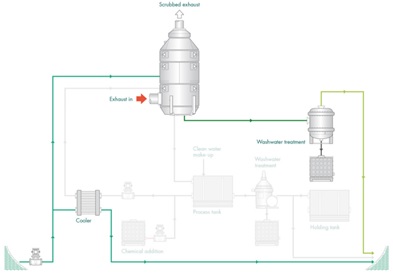
Hybrid exhaust gas cleaning system open-loop operation
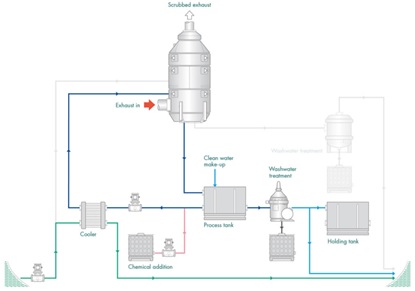
Hybrid exhaust gas cleaning system closed-loop operation
Advantages:
1. Suitable for long and short voyages around the world
2. Ships with Hybrid scrubbing systems can spend more time in ECA zones and on port than those with open loop systems
3. Can use lower costing HFO (Heavy Fuel Oil) all of the time
Disadvantage:
1. More structural modifications are needed to employ this system.
2. Requires large storage space for chemicals and additives.
3. The system has a high installation time and cost.
.
Choice of Scrubber System
In order for a shipping company to select the most suitable kind of scrubber system to be installed on board, there are many factors it must consider. These include; the installation spaces available on board, the area of operation and the chartering schedule of the ship, the power and output of the engine and boiler on board, the availability of fresh water on board and the available power on board to run the system in different conditions, amongst others.
Your Comments
Other news
Mobil Serv℠ Cylinder Condition Monitoring, ExxonMobil’s next-generation onboard scrape down oil analysis service, has evolved.
The use of mass flow metering systems (MFMS) has gained traction around the world following their mandatory use in the Port of Singapore, MFMS has set a global benchmark for bunkering by ...
Mobil Serv℠ Cylinder Condition Monitoring, ExxonMobil’s next-generation onboard scrape down oil analysis service, has evolved.
The International Maritime Organization’s (IMO) 2020 emissions regulation radically changed the industry’s fuels landscape, which in turn raised questions amongst vessel operators ...
Across the industry, some vessels that switched to compliant low-sulphur fuel have seen increased engine issues.
Energy efficiency tests revealed big savings for ExxonMobil distributor in the Netherlands, Den Hartog, with a reduction in total energy losses of approximately 10% and a savings of about EUR 1400, ...







__DSC01225-1024x536.jpg)
__MFM.jpg)
__aaa.jpg)
__maxresdefault.jpg)
__iStock-595157980-p08zcpkjw8jg2i1ticiukg441xdktfvys8beyfc0xs.jpg)
__new_02-20-01_1.jpg)
